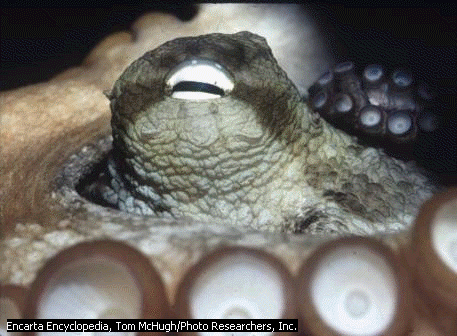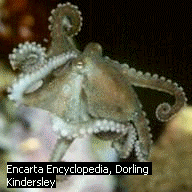 The
octopus has the most well-developed eye in the invertebrate world.
In structure and function the octopus eye is very similar to that of
higher vertebrates such as fish, mammals, and humans.
The
octopus has the most well-developed eye in the invertebrate world.
In structure and function the octopus eye is very similar to that of
higher vertebrates such as fish, mammals, and humans.Octopus
 The
octopus has the most well-developed eye in the invertebrate world.
In structure and function the octopus eye is very similar to that of
higher vertebrates such as fish, mammals, and humans.
The
octopus has the most well-developed eye in the invertebrate world.
In structure and function the octopus eye is very similar to that of
higher vertebrates such as fish, mammals, and humans.
An octopus is a carnivorous marine mollusk (which does not create a shell), found worldwide in tropical and warm temperate waters. The octopus is characterized by a soft body with a well-developed brain and by eight arms bearing two rows of suckers each. As in the vertebrates, the two large, complex eyes of the octopus are cameralike in structure, and their vision is acute. The animals can change the color and texture of their skin rapidly. Much of their life is spent in hiding, and many species—such as the common octopus, which can grow to about 1 m (about 3 ft) long—choose a natural hole among rocks or in a pile of rubble. A small species, however, such as the Atlantic pygmy octopus, which is about 2 cm (about 5 in) long, may prefer an empty clamshell having both valves still connected by a ligament; settling into one half, it pulls the shell shut with its suckers.
 The
common octopus has the typical octopus body form consisting of three
main regions: the mantle, limbs, and head. The mantle, a large,
muscular, bulbous sac, contains most of the internal organs,
including the gills, digestive tract, ink sac, and reproductive
organs. The limbs consist of eight arms. Along the length of each arm
is a double row of suckers equipped with tactile and olfactory receptors.
The
common octopus has the typical octopus body form consisting of three
main regions: the mantle, limbs, and head. The mantle, a large,
muscular, bulbous sac, contains most of the internal organs,
including the gills, digestive tract, ink sac, and reproductive
organs. The limbs consist of eight arms. Along the length of each arm
is a double row of suckers equipped with tactile and olfactory receptors.
When an octopus emerges to find food such as crustaceans and bivalve mollusks, it often lures its victim by wiggling the tip of an arm like a worm; or it glides near and pounces on a crab, sinking its beak into the shell and injecting a poison that kills; the poison of a very few species is dangerous to humans. Octopuses are preyed upon in turn by a number of fishes, including the moray eel. When an octopus is attacked, it draws water into its mantle cavity and expels it with great force through a funnel. The result is a jet-propelled exit, usually behind a cloud of “ink,” a dark substance the octopus ejects for defense. The ink of some species seems to have a paralyzing effect on the sensory organs of the predator.
 The
octopus escapes from predators such as fishes, whales and divers by
ejecting a cloud of ink into the water. This ink, which is used only
as a defense mechanism, confuses predators and masks the retreat of
the octopus.
The
octopus escapes from predators such as fishes, whales and divers by
ejecting a cloud of ink into the water. This ink, which is used only
as a defense mechanism, confuses predators and masks the retreat of
the octopus.
A male interested in mating approaches a female just close enough to stretch out a modified arm, the hectocotylus, and caress the female. This arm has a deep groove between the two rows of suckers and ends in a spoonlike tip. After a period of love play the male inserts its arm under the mantle of the female, and the spermatophores travel down the groove on the hectocotylus to the female's oviduct. Soon after mating, the female begins to lay eggs, each enclosed in a transparent capsule, in its lair, producing about 150,000 in two weeks. The female guards them for the next 50 days, jetting water to aerate and clean them. The young of such species as the white-spotted octopus are only about 3 mm (about 0.12 in) long. They float to the surface and become part of the plankton for about a month, then sink and begin their normal life on the bottom. Octopuses generally stay in one area as adults, but those species with planktonic larvae are found all over the world because the currents and tides move them.
Scientific classification: Octopuses belong to the order Octopoda. The common octopus is classified as Octopus vulgaris, the Atlantic pygmy octopus as Octopus joubini, and the white-spotted octopus as Octopus macropus, all of the family Octopodidae.
Microsoft ® Encarta ® Encyclopedia 2002. © 1993-2001 Microsoft Corporation. All rights reserved.